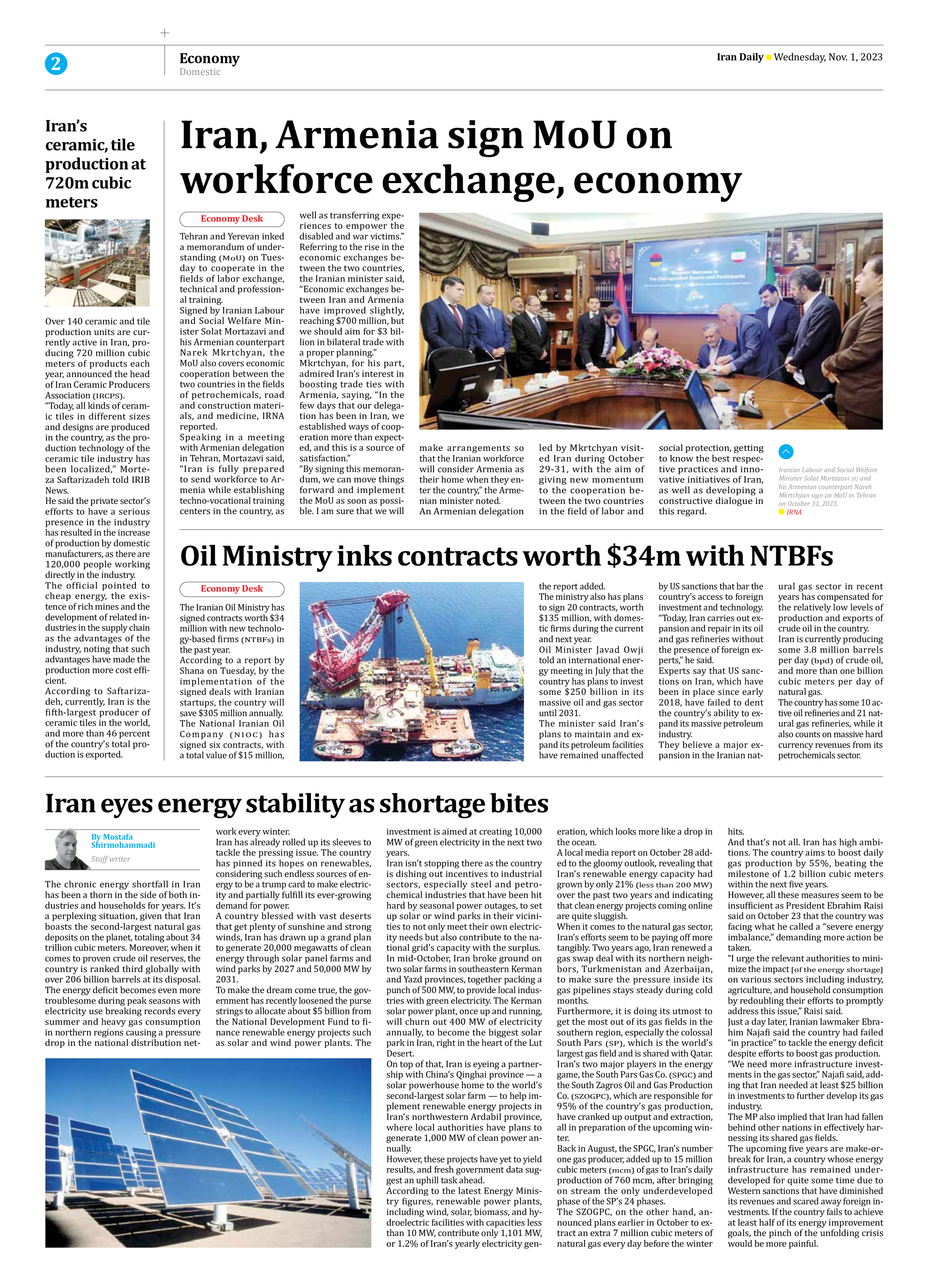
Iran eyes energy stability as shortage bites
By Mostafa Shirmohammadi
Staff writer
The chronic energy shortfall in Iran has been a thorn in the side of both industries and households for years. It’s a perplexing situation, given that Iran boasts the second-largest natural gas deposits on the planet, totaling about 34 trillion cubic meters. Moreover, when it comes to proven crude oil reserves, the country is ranked third globally with over 206 billion barrels at its disposal. The energy deficit becomes even more troublesome during peak seasons with electricity use breaking records every summer and heavy gas consumption in northern regions causing a pressure drop in the national distribution network every winter.
Iran has already rolled up its sleeves to tackle the pressing issue. The country has pinned its hopes on renewables, considering such endless sources of energy to be a trump card to make electricity and partially fulfill its ever-growing demand for power.
A country blessed with vast deserts that get plenty of sunshine and strong winds, Iran has drawn up a grand plan to generate 20,000 megawatts of clean energy through solar panel farms and wind parks by 2027 and 50,000 MW by 2031.
To make the dream come true, the government has recently loosened the purse strings to allocate about $5 billion from the National Development Fund to finance renewable energy projects such as solar and wind power plants. The investment is aimed at creating 10,000 MW of green electricity in the next two years.
Iran isn’t stopping there as the country is dishing out incentives to industrial sectors, especially steel and petrochemical industries that have been hit hard by seasonal power outages, to set up solar or wind parks in their vicinities to not only meet their own electricity needs but also contribute to the national grid’s capacity with the surplus.
In mid-October, Iran broke ground on two solar farms in southeastern Kerman and Yazd provinces, together packing a punch of 500 MW, to provide local industries with green electricity. The Kerman solar power plant, once up and running, will churn out 400 MW of electricity annually, to become the biggest solar park in Iran, right in the heart of the Lut Desert.
On top of that, Iran is eyeing a partnership with China’s Qinghai province — a solar powerhouse home to the world’s second-largest solar farm — to help implement renewable energy projects in Iran’s northwestern Ardabil province, where local authorities have plans to generate 1,000 MW of clean power annually.
However, these projects have yet to yield results, and fresh government data suggest an uphill task ahead.
According to the latest Energy Ministry figures, renewable power plants, including wind, solar, biomass, and hydroelectric facilities with capacities less than 10 MW, contribute only 1,101 MW, or 1.2% of Iran’s yearly electricity generation, which looks more like a drop in the ocean.
A local media report on October 28 added to the gloomy outlook, revealing that Iran’s renewable energy capacity had grown by only 21% (less than 200 MW) over the past two years and indicating that clean energy projects coming online are quite sluggish.
When it comes to the natural gas sector, Iran’s efforts seem to be paying off more tangibly. Two years ago, Iran renewed a gas swap deal with its northern neighbors, Turkmenistan and Azerbaijan, to make sure the pressure inside its gas pipelines stays steady during cold months.
Furthermore, it is doing its utmost to get the most out of its gas fields in the southern region, especially the colossal South Pars (SP), which is the world’s largest gas field and is shared with Qatar.
Iran’s two major players in the energy game, the South Pars Gas Co. (SPGC) and the South Zagros Oil and Gas Production Co. (SZOGPC), which are responsible for 95% of the country’s gas production, have cranked up output and extraction, all in preparation of the upcoming winter.
Back in August, the SPGC, Iran’s number one gas producer, added up to 15 million cubic meters (mcm) of gas to Iran’s daily production of 760 mcm, after bringing on stream the only underdeveloped phase of the SP’s 24 phases.
The SZOGPC, on the other hand, announced plans earlier in October to extract an extra 7 million cubic meters of natural gas every day before the winter hits.
And that’s not all. Iran has high ambitions. The country aims to boost daily gas production by 55%, beating the milestone of 1.2 billion cubic meters within the next five years.
However, all these measures seem to be insufficient as President Ebrahim Raisi said on October 23 that the country was facing what he called a “severe energy imbalance,” demanding more action be taken.
“I urge the relevant authorities to minimize the impact [of the energy shortage] on various sectors including industry, agriculture, and household consumption by redoubling their efforts to promptly address this issue,” Raisi said.
Just a day later, Iranian lawmaker Ebrahim Najafi said the country had failed “in practice” to tackle the energy deficit despite efforts to boost gas production.
“We need more infrastructure investments in the gas sector,” Najafi said, adding that Iran needed at least $25 billion in investments to further develop its gas industry.
The MP also implied that Iran had fallen behind other nations in effectively harnessing its shared gas fields.
The upcoming five years are make-or-break for Iran, a country whose energy infrastructure has remained underdeveloped for quite some time due to Western sanctions that have diminished its revenues and scared away foreign investments. If the country fails to achieve at least half of its energy improvement goals, the pinch of the unfolding crisis would be more painful.







